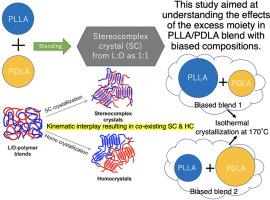Kinematic Interplay of Homopolymer Crystallization with Stereocomplex Formation in Poly(L-lactic acid) / Poly(D-lactic acid) Blends Having Asymmetric Compositions 1. Effects of Molecular Weights of Polymers
IF 4.5
2区 化学
Q2 POLYMER SCIENCE
引用次数: 0
Abstract
Poly(lactic acid) is a biobased polymer and a promising material to contribute sustainability. Many reports have been published to improve its mechanical and thermal properties. Among them, crystallization behaviors are one of the main topics. It is known that equimolar mixing of poly(L-lactic acid) / poly(D-lactic acid) (PLLA/PDLA) forms stereocomplex crystal (SC), in addition to the crystallization of these individual homopolymer moieties. In this study, effects of blend composition were investigated to understand the roles of the excess moiety in the PLLA/PDLA blends having asymmetric compositions. For this purpose, DSC (differential scanning calorimetry), POM (polarizing optical microscopy), and WAXD (wide-angle X-ray diffraction) measurements have been conducted. One of the significant results is a remarkably high amount formation of homocrystal (HC) in the 20/80 blend, which contributes the total degree of crystallinity (χtotal = χSC + χHC) where χSC and χHC denote the crystallinity of SC and HC, respectively. This further may contribute prevention of thermal contraction of the blend specimens at temperature below 100˚C when χtotal exceeds 50%. Since it is considered that the 50/50 blend is the best to attain the maximum crystallinity, the experimental result showing the maximum crystallinity of the 20/80 blend is surprising. Furthermore, for the opposed composition, i.e., the 80/20 blend, the total crystallinity is not so high. Namely, it was found that the dependencies of χtotal, χSC, χHC, and the growth rate of the spherulite as a function of the blend composition exhibited asymmetric features. This result suggests that the excess moiety in the biased blend (i.e., 20/80 vs. 80/20) did not play completely an identical role. It is speculated that the subtle difference in the molecular weights of PLLA and PDLA samples used in this study may even ascribe to the asymmetric tendency of the effects of the blend composition.

不对称组成的聚l -乳酸/聚d -乳酸共混物中均聚物结晶与立体配合物形成的运动学相互作用聚合物分子量的影响
聚乳酸是一种生物基聚合物,是一种很有前途的可持续发展材料。已经发表了许多关于改善其机械和热性能的报告。其中,结晶行为是研究的主要内容之一。已知聚l -乳酸/聚d -乳酸(PLLA/PDLA)的等摩尔混合除了形成这些单体均聚物的结晶外,还形成立体配合物晶体(SC)。在本研究中,研究了共混物组成的影响,以了解过量部分在具有不对称组成的PLLA/PDLA共混物中的作用。为此,进行了DSC(差示扫描量热法),POM(偏光光学显微镜)和WAXD(广角x射线衍射)测量。其中一个显著的结果是,在20/80混合物中,均晶(HC)的形成量非常高,这对总结晶度有贡献(χtotal = χSC + χHC),其中χSC和χHC分别表示SC和HC的结晶度。这进一步有助于防止混合试样在温度低于100℃时的热收缩,χ总数大于50%。由于认为50/50共混物能获得最大结晶度,所以实验结果显示20/80共混物的最大结晶度令人惊讶。此外,对于相反的组合物,即80/20共混物,总结晶度不那么高。结果表明,χtotal、χSC、χHC与球晶生长率随共混物组成的关系呈现不对称特征。这一结果表明,偏置混合(即20/80 vs. 80/20)中多余的部分并没有发挥完全相同的作用。据推测,本研究中使用的PLLA和PDLA样品分子量的细微差异甚至可能归因于共混物组成效应的不对称倾向。
本文章由计算机程序翻译,如有差异,请以英文原文为准。
求助全文
约1分钟内获得全文
求助全文
来源期刊

Polymer
化学-高分子科学
CiteScore
7.90
自引率
8.70%
发文量
959
审稿时长
32 days
期刊介绍:
Polymer is an interdisciplinary journal dedicated to publishing innovative and significant advances in Polymer Physics, Chemistry and Technology. We welcome submissions on polymer hybrids, nanocomposites, characterisation and self-assembly. Polymer also publishes work on the technological application of polymers in energy and optoelectronics.
The main scope is covered but not limited to the following core areas:
Polymer Materials
Nanocomposites and hybrid nanomaterials
Polymer blends, films, fibres, networks and porous materials
Physical Characterization
Characterisation, modelling and simulation* of molecular and materials properties in bulk, solution, and thin films
Polymer Engineering
Advanced multiscale processing methods
Polymer Synthesis, Modification and Self-assembly
Including designer polymer architectures, mechanisms and kinetics, and supramolecular polymerization
Technological Applications
Polymers for energy generation and storage
Polymer membranes for separation technology
Polymers for opto- and microelectronics.
 求助内容:
求助内容: 应助结果提醒方式:
应助结果提醒方式:


